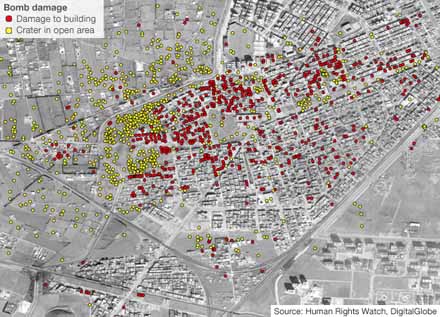Russian and Chinese Arms Sales to Authoritarian Regimes – Part 2 (China)
China: The Evil Twin?
This article is Part 2 of Russian and Chinese Arms Sales to Authoritarian Regimes. Part 1 can be found here.
This article is also available in Arabic (العربية) at Free Syrian Translators
As Russia equips the world’s authoritarian regimes with the means to discourage Western intervention, China is selling them one of the worst tools of oppression against their own people: artillery.
(Artillery, as defined by the FAS report, includes field and air defense artillery, mortars, rocket launchers and recoiless rifles and FROG launchers 100mm and over)
Artillery sold by China (2003-2010): 1,890
Artillery sold by the US (2003-2010): 390
Why artillery? Assad’s shelling of Syrian cities like Homs shows how essential artillery is to waging an effective campaign against a popular uprising.

- Map showing artillery damage after Assad’s army bombed Homs, Syria
In Syria, the use of artillery by Bashar al-Assad has accomplished numerous goals:
- Artillery has allowed Assad to avoid the mistake that Muammar Gaddafi made – using airpower to bombard the opposition – which led to calls for a no-fly zone and eventually Western military intervention to remove the regime.
- Artillery bombardment allows the regime to kill not only freedom fighters but also civilians, reducing the pool of potential recruits and dramatically increasing the war weariness of the population.
- The large-scale destruction of towns and cities serves as a warning to the civilian population not to support the uprising, and discourages rebels from holding ground in cities because of the destruction the regime response will cause.
- Using artillery provides the regime with some plausible deniability of intent when civilian buildings are hit (such as hospitals or media centers) because it is indirect fire.
- Artillery allows the regime to bombard the enemy from a distance, keeping the army together so as to prevent individual units from defecting to the other side.
These Chinese artillery purchases are in addition to all of the Russian artillery already purchased by the regimes in the past and doesn’t even include the smaller mortars (60mm and 80mm). Syria and other authoritarian regimes have acquired a truly massive stockpile of artillery rounds for leveling cities and destroying any uprising against their rule.
China has been particularly aggressive with artillery sales to Africa. Algeria, Sudan, and Egypt (under Hosni Mubarak) have purchased the 155mm howitzers from China. China shipped mortars and rockets to President Robert Mugabe in Zimbabwe despite international pressure in 2008.
When the regimes don’t have enough cash to pay for the weapons China negotiates trade deals for the natural resources of the countries, allowing the regimes to further pillage the country and the resources of its people in exchange for the arms to remain in power. This is part of the reason that China deals with pariah states under sanction by other countries; in their weakened state the regimes are forced to enter into resource deals on terms very benficial to China in exchange for weapons. This allows China to expand influence in the Third World and obtain resources it depends on for economic growth.
Protecting Their Investment
The Russian and Chinese arms trade with authoritarian regimes isn’t just about money and resources. Russia and China view themselves as superpowers intent on spreading their influence throughout the world. Chinese weapons are viewed as cheap substitutes for Russian arms and as a consequence they’re the budget alternative for many authoritarian regimes. With China’s focus on economic power as their means of influence in the world this presents an opportunity for them to ship cheap weapons to the Third World in exchange for favorable trade terms, natural resources, and establishing a foothold in developing countries.

